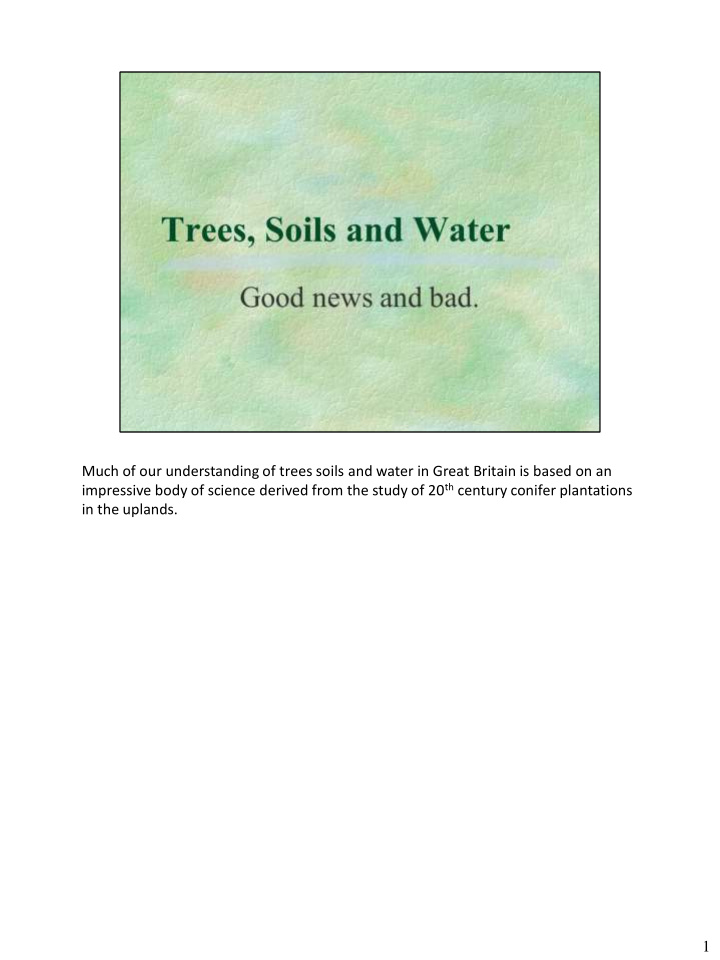



Much of our understanding of trees soils and water in Great Britain is based on an impressive body of science derived from the study of 20 th century conifer plantations in the uplands. 1
It’s worth looking at the origins of plantation forestry. 2
The Forestry Commission was founded in 1919 to establish a strategic reserve of timber for future conflict. Here we ca see Timber Jills in the Second World War stacking pit props to dry. Small diameter coniferous roundwood was the lifeblood of British mining before nationalisation brought modernisation in 1947 4
Note the attention to Health and Safety – cap turned round and eyes tight shut! 5
The establishment of plantations required extensive drainage works in the uplands, many areas of peatland which were natural reservoirs were drained. 6
Changes to the hydrology were profound and still affect many catchments today. 7
When crops are harvested, the exposure of soil and the rapid decay of root systems can cause acidification of streams. 8
This is exacerbated when further cultivation is required prior to re-planting. 9
The scale of clear-felling and re-planting is a very British thing. It is this that has cast trees as the villains in the minds of fishermen. hydrologists and water supply engineers. 10
But there is another side to this story. 11
The damage is reversible and there is a growing body of evidence that it works. 12
Here conifer brash has been packed into the drains. 13
Success, the water table recovers quickly but it’s not just about removing trees. Not far from these sites in the Upper Severn. The Pontbren Farmers Group have been using trees and hedges to improve their stock management since 1997. 14
The Group began by taking a critical look at their farm businesses. A lack of good shelter was identified as a barrier to lowering costs. 15
Unfenced streams, often in steep-sided gullies were a hazard to stock and a risk to biosecurity. 16
This was an obvious place to start planting trees for shelter. 17
An efficient shelterbelt should be dense at the bottom and thin at the top. Note the hedge on the sunny side. 18
Ponds and wetlands were identified as sources of fluke and foot-rot. Better to fence the stock out. This pond now supplies troughs in a number of fields. 19
The environmental consequences were a happy accident but they triggered a major piece of research by a consortium of universities led by Prof, Howard Wheater of Imperial College 20
Overland flow is a significant and frequent problem, contributing to soil loss, flooding and diffuse pollution. 21
Soil in shelterbelts is more porous than adjacent pasture. There is significant benefit after 2 years. 22
This experiment shows the extent to which newly planted birch and ash draw rainwater into deeper layers of impervious clay. 23
Tree species choice is important. Most native trees and shrubs have deep roots. Take care when planting near drains. 24
Narrow strips of trees, planted along contours, effectively eliminate overland flow. Buffer strips with trees are typically 12 times as efficient as grass buffer strips. 25
About two thirds of this storm reached the stream directly off the surface, It didn’t make it to the drains. 26
The huge body of data collected over several years has been analysed and used to model the likely impacts in wider catchments. 27
This flood in Jan 2007 suggests significant benefit from strategically placed shelterbelts occupying perhaps 5% of the farm 28
The experience at Pontbren shows how well placed shelterbelts and hedgerows contribute to good stock husbandry and provide environmental benefits. The decision making at Pontbren has been all down to the farmers. Are there ways we can help that planning process? 29
30
This Scimap system developed by Durham University for the Rivers Trusts looks promising. On this evidence the farmers know best! 31
32
33
34
35
There is more information on the Coed Cymru website and we will be happy to provide access to the published research. 36
Recommend
More recommend